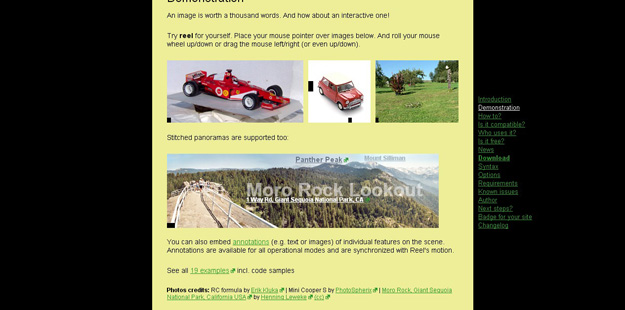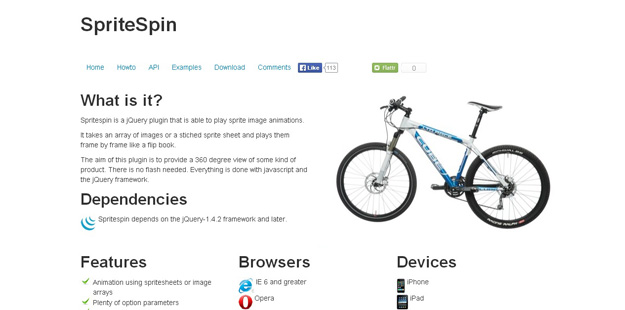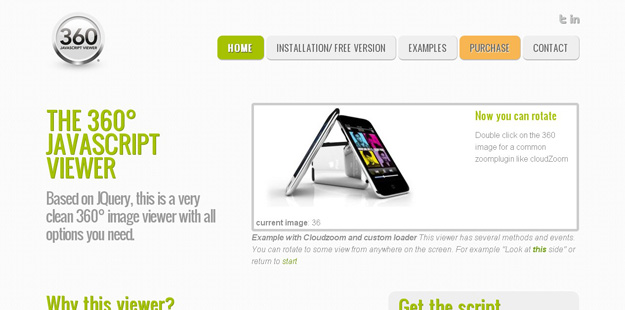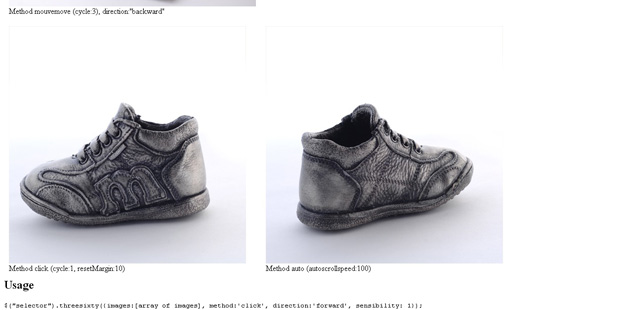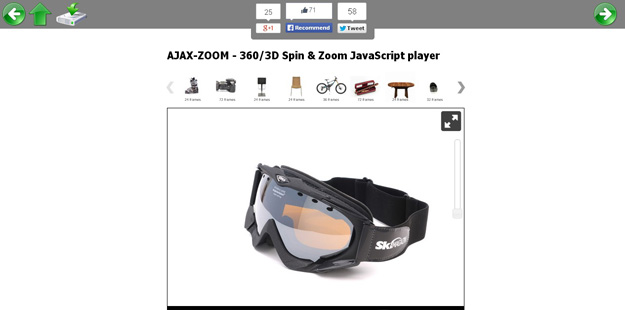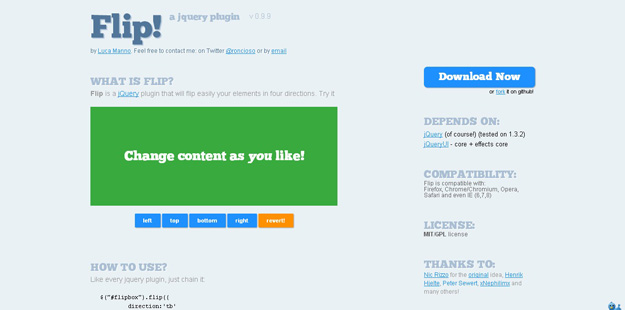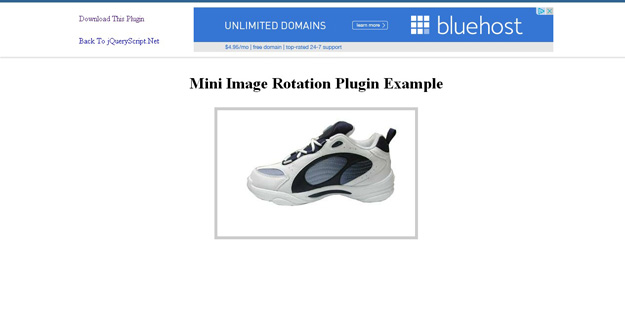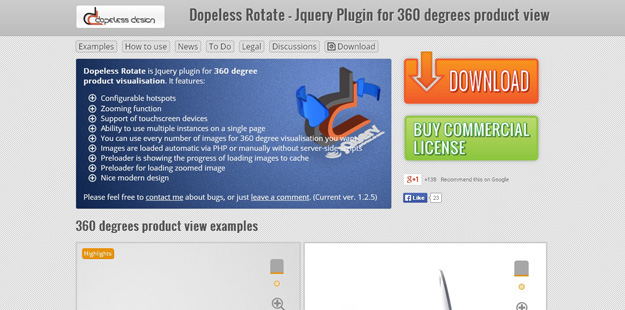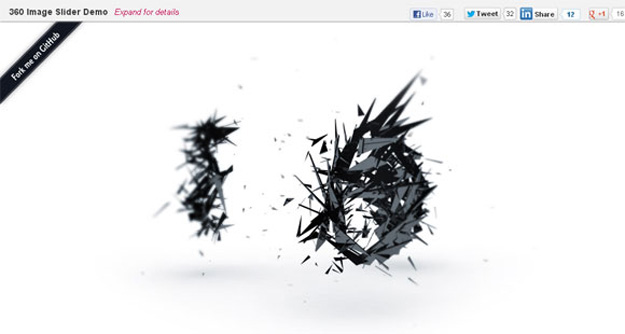 Web Front-end
Web Front-end
 JS Tutorial
JS Tutorial
 13 of the most popular jQuery image 360-degree rotation plug-ins recommended_jquery
13 of the most popular jQuery image 360-degree rotation plug-ins recommended_jquery
13 of the most popular jQuery image 360-degree rotation plug-ins recommended_jquery
Using the jQuery image 360-degree rotation plug-in is the most beautiful and convenient way to display images on a web page. These awesome 360° image selection plugins allow users to analyze products or articles in greater detail. The jQuery image rotation plug-in allows users to display 360-degree images from various angles. It is often used on e-commerce websites to help consumers better understand products and observe and appreciate them from any angle.
In this article, we have collected 13 of the best jQuery image 360-degree rotation plug-ins, which can perform 360-degree image rotation display. I hope you can find what you like and apply it to your own website.
1. Reel
Reel is a completed project, a very complete jQuery image 360-degree rotation plug-in. It uses new technology to turn ordinary image markers into a full 360-degree interactive object movie, panorama or stop-motion animation.
2. SpriteSpin
Spritespin is a jQuery plug-in that allows sprite animations to be displayed on web pages. The user only needs to provide a set of images, or a seamless series of sprite lists, and these images can be displayed frame by frame, and then the animation can be generated. Online demo
3. The 360 Degree JavaScript Viewer
The 360 degree Javascript viewer is a jQuery plug-in used to display a beautiful 360-degree image rotation effect. Online demo
4. jQuery Panorama Viewer
jQuery Panorama Viewer can help users embed panoramic images into the user's website. To achieve this effect, first, users need to include the latest jQuery library, including jquery.panorama_viewer.js and panorama_viewer.css, and then add the image to the "panorama" class of HTML. Supported modern mainstream browsers: Chrome, Firefox and Safari (desktop and mobile). Online demo
5. jQuery Threesixty
jQuery Threesixty is a small plug-in used to build flash-like panoramic images, or natural 360° view displays of images. Online demo
6. Ajax Zoom
AJAX-ZOOM is a unique “Flash” free tool for 360-degree product photos. Users can rotate images 360 degrees while displaying 3D effects and performing depth zoom. This plugin uses image blocking technology (image stacking) to create high-resolution images.
7. jQuery Image Cube
jQuery Image Cube is a jQuery plug-in that can rotate images separately to achieve a 360° rotation effect.
8. Flip
Flip is a jQuery plug-in that allows flipping images in four directions.
9. Super Tiny jQuery 360 Degree Product Viewer
Super Tiny jQuery 360 Degree Product Viewer is super lightweight (only 27 lines of javaScript code, about 1 kb). This is a very easy-to-use jQuery plugin that allows users to display images from 360 degrees by moving the mouse.
10. 3dEye.js
3dEye.js is a lightweight, fast jQuery plug-in that allows users to create 3D views of objects through images. It is very friendly to mobile devices and touch devices, and supports various mainstream browsers. Using this plugin, users can use their mouse to display images in 360 degrees on the website.
11. Dopeless Rotate
Dopeless Rotate is a jQuery plug-in for 360-degree rotation display of images. It includes zoom function, supports touch devices, and allows the use of multiple plug-ins on the same page.
12. 360 Degree Image Slide
The 360 Degree Image slider is created using JS, CSS and pre-rendered image sequences, allowing users to drag and rotate 3D objects around the y-axis using simple mouse or touch events.
13. 360 Slider
ThreeSixty Image Slider Plugin is a jQuery 360-degree image rotation plug-in. This plugin can be customized with digital options to display a 360 rotation of the image in any orientation.
The above is a brief introduction to these 13 jQuery image rotation plug-ins. You can choose freely according to your own project needs. Click on the picture to enter the official website. There are detailed introduction instructions and usage methods, not much here. That's nonsense.

Hot AI Tools

Undresser.AI Undress
AI-powered app for creating realistic nude photos

AI Clothes Remover
Online AI tool for removing clothes from photos.

Undress AI Tool
Undress images for free

Clothoff.io
AI clothes remover

AI Hentai Generator
Generate AI Hentai for free.

Hot Article

Hot Tools

Notepad++7.3.1
Easy-to-use and free code editor

SublimeText3 Chinese version
Chinese version, very easy to use

Zend Studio 13.0.1
Powerful PHP integrated development environment

Dreamweaver CS6
Visual web development tools

SublimeText3 Mac version
God-level code editing software (SublimeText3)

Hot Topics
 Detailed explanation of jQuery reference methods: Quick start guide
Feb 27, 2024 pm 06:45 PM
Detailed explanation of jQuery reference methods: Quick start guide
Feb 27, 2024 pm 06:45 PM
Detailed explanation of jQuery reference method: Quick start guide jQuery is a popular JavaScript library that is widely used in website development. It simplifies JavaScript programming and provides developers with rich functions and features. This article will introduce jQuery's reference method in detail and provide specific code examples to help readers get started quickly. Introducing jQuery First, we need to introduce the jQuery library into the HTML file. It can be introduced through a CDN link or downloaded
 How to remove the height attribute of an element with jQuery?
Feb 28, 2024 am 08:39 AM
How to remove the height attribute of an element with jQuery?
Feb 28, 2024 am 08:39 AM
How to remove the height attribute of an element with jQuery? In front-end development, we often encounter the need to manipulate the height attributes of elements. Sometimes, we may need to dynamically change the height of an element, and sometimes we need to remove the height attribute of an element. This article will introduce how to use jQuery to remove the height attribute of an element and provide specific code examples. Before using jQuery to operate the height attribute, we first need to understand the height attribute in CSS. The height attribute is used to set the height of an element
 How to use PUT request method in jQuery?
Feb 28, 2024 pm 03:12 PM
How to use PUT request method in jQuery?
Feb 28, 2024 pm 03:12 PM
How to use PUT request method in jQuery? In jQuery, the method of sending a PUT request is similar to sending other types of requests, but you need to pay attention to some details and parameter settings. PUT requests are typically used to update resources, such as updating data in a database or updating files on the server. The following is a specific code example using the PUT request method in jQuery. First, make sure you include the jQuery library file, then you can send a PUT request via: $.ajax({u
 jQuery Tips: Quickly modify the text of all a tags on the page
Feb 28, 2024 pm 09:06 PM
jQuery Tips: Quickly modify the text of all a tags on the page
Feb 28, 2024 pm 09:06 PM
Title: jQuery Tips: Quickly modify the text of all a tags on the page In web development, we often need to modify and operate elements on the page. When using jQuery, sometimes you need to modify the text content of all a tags in the page at once, which can save time and energy. The following will introduce how to use jQuery to quickly modify the text of all a tags on the page, and give specific code examples. First, we need to introduce the jQuery library file and ensure that the following code is introduced into the page: <
 Use jQuery to modify the text content of all a tags
Feb 28, 2024 pm 05:42 PM
Use jQuery to modify the text content of all a tags
Feb 28, 2024 pm 05:42 PM
Title: Use jQuery to modify the text content of all a tags. jQuery is a popular JavaScript library that is widely used to handle DOM operations. In web development, we often encounter the need to modify the text content of the link tag (a tag) on the page. This article will explain how to use jQuery to achieve this goal, and provide specific code examples. First, we need to introduce the jQuery library into the page. Add the following code in the HTML file:
 How to tell if a jQuery element has a specific attribute?
Feb 29, 2024 am 09:03 AM
How to tell if a jQuery element has a specific attribute?
Feb 29, 2024 am 09:03 AM
How to tell if a jQuery element has a specific attribute? When using jQuery to operate DOM elements, you often encounter situations where you need to determine whether an element has a specific attribute. In this case, we can easily implement this function with the help of the methods provided by jQuery. The following will introduce two commonly used methods to determine whether a jQuery element has specific attributes, and attach specific code examples. Method 1: Use the attr() method and typeof operator // to determine whether the element has a specific attribute
 Understand the role and application scenarios of eq in jQuery
Feb 28, 2024 pm 01:15 PM
Understand the role and application scenarios of eq in jQuery
Feb 28, 2024 pm 01:15 PM
jQuery is a popular JavaScript library that is widely used to handle DOM manipulation and event handling in web pages. In jQuery, the eq() method is used to select elements at a specified index position. The specific usage and application scenarios are as follows. In jQuery, the eq() method selects the element at a specified index position. Index positions start counting from 0, i.e. the index of the first element is 0, the index of the second element is 1, and so on. The syntax of the eq() method is as follows: $("s
 Summary of commonly used file operation functions in PHP
Apr 03, 2024 pm 02:52 PM
Summary of commonly used file operation functions in PHP
Apr 03, 2024 pm 02:52 PM
目录1:basename()2:copy()3:dirname()4:disk_free_space()5:disk_total_space()6:file_exists()7:file_get_contents()8:file_put_contents()9:filesize()10:filetype()11:glob()12:is_dir()13:is_writable()14:mkdir()15:move_uploaded_file()16:parse_ini_file()17:



